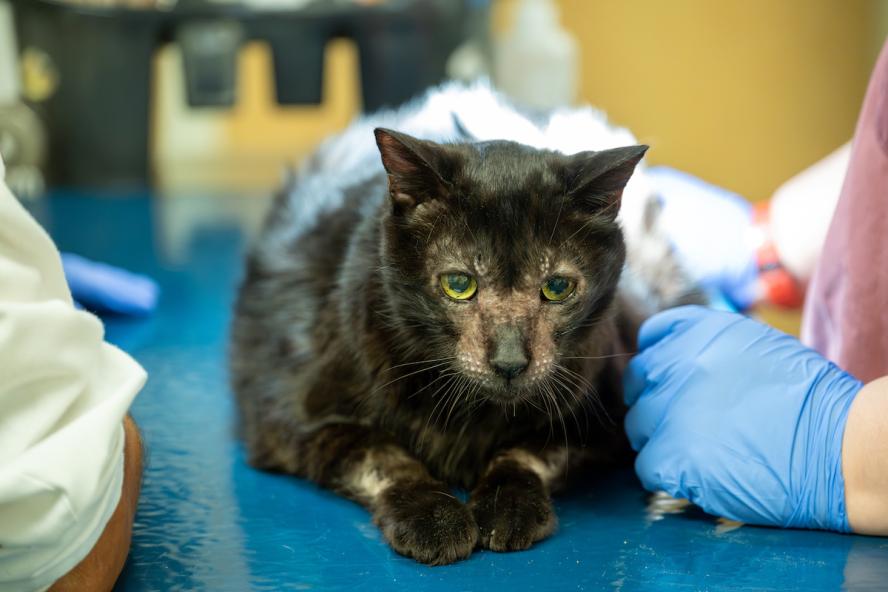-
About
- Leadership & Faculty
- News & Events
-
Academics
- Graduate
- Advanced Clinical Training
- Continuing Education
- Academic Departments
- Academic Offices
- Simulation Experiences
-
Student Life
- Offices
-
Research
-
Hospitals & Clinics
- Emergency Care
- Hospital Services
-
Community Outreach
- Volunteer
From Despair to Elation
14-year-old cat saved from end-of-life decision

When Carolyn Roux (she/her) brought her 14-year-old black cat, Lionel, to Henry and Lois Foster Hospital for Small Animals at Cummings School of Veterinary Medicine at Tufts University, she had come to terms with an extremely difficult decision. She did not want him to suffer any longer.
Lionel had long endured skin outbreaks on his face and jaw. Roux tried many options, including diet changes and medications for more than a year, but the remedies were unsuccessful. “His face was so swollen that his eyelashes were turning inward and scratching his eye,” Roux laments. “We didn’t know what to do and felt that he had suffered enough.”
Dr. Armelle de Laforcade, V97 (she/her), a criticalist on Foster Hospital’s Emergency and Critical Care team, met with Carolyn and her boyfriend, David Yahnian. “Many pets that present for euthanasia look like they’re really struggling, really old, or not very responsive,” de Laforcade explains. “Lionel was hanging out on the couch with his owners, sitting up with his paws curled, so I sat down and talked to them.”
After examining Lionel and gathering his history, medical intervention, and treatments, de Laforcade felt that he may have a chance with the proper care, so she asked, “Do you want me to see if dermatologists could take a look at him?” They agreed.
de Laforcade estimates that Foster Hospital sees nearly 100 animals each month for euthanasia. “It’s a difficult situation, because one of the things I feel strongly about and I teach our students is that when people have made a decision that they're ready for end-of-life care, you shouldn't try that hard to talk them out of it,” she says. “They’re ready. But Lionel was not a typical client.”
Once the owners approved, de Laforcade picked up Lionel and headed to Dermatology. She admits, “I thought to myself, what am I doing?” de Laforcade explained the situation to Dr. Ramón Almela (he/him), veterinary dermatologist and assistant professor in the Department of Clinical Sciences.
“He did not look good because of all he’d been through, and he wasn’t eating,” Almeda said about Lionel. “But after learning his history and checking him out, we thought there were a few things we could try because I thought he had a chance to improve. We felt that we could treat his skin infection with a specific anti-inflammatory treatment and we could offer that option to the owner. Usually with this type of treatment, similar cases show signs of improvement pretty quickly.”
After receiving a treatment plan for Lionel from Dermatology, de Laforcade stopped by Ophthalmology. “There, we decided that if the skin condition was treated, the eye condition would improve,” she says.
Upon returning to speak with Carolyn and David, de Laforcade told them, “If moving forward with euthanasia is what’s best for your family, I can respect that. We’ll do that for you. Dermatology has looked at Lionel and they feel that they can help you, they would recommend that you do X, Y, and Z, and they can see you back for a recheck in a couple of weeks. And we would start medication for the eye.”
Carolyn and David were elated. “We couldn’t believe it,” she says. “We went from sad to super happy.”
Lionel was diagnosed with Feline Atopic Syndrome or skin allergies. This resolved initially with oral glucocorticoid, flea and tick control, antiseptic wipes, and an antibiotic. Once the condition was in remission, the treatment included continuing flea control and oral cyclosporine as anti-allergic treatment.
They brought Lionel home, followed the treatment plan and noticed improvement quickly. Lionel has since returned to Foster Hospital for follow-up appointments and is doing well. “Fortunately, he had some allergies and not something more severe,” Almela explains. “He is still improving, and we are managing his allergies, long-term.”
Carolyn cherishes her furry family member and is thrilled to continue enjoying his company. “I’m so glad we got an opportunity to get Lionel the help he needed,” Carolyn says. “It’s amazing he’s still here with us, enjoying life, playing, and burrowing.”
An extremely rare case such as this highlights one of the current challenges in veterinary care, de Laforcade shares. “I feel really good about how this case turned out,” she says. “However, we’re in a difficult situation in veterinary medicine with a shortage of veterinarians and access to care is less than what we want it to be. We try to emphasize that the most cost-effective way of getting help for a pet is to establish a relationship with a specialty that you need.”
At Cummings School, highly skilled and compassionate clinicians among its seven hospitals and clinics consult regularly with speciality services, determined on a case-by-case basis, to provide the best care available for each client and their owner.
Department:
Foster Hospital for Small Animals